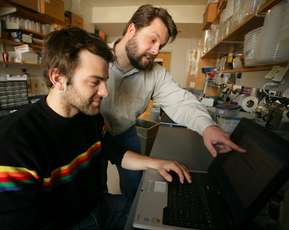New evidence that natural selection is a general driving force behind the origin of species

Charles Darwin would undoubtedly be both pleased and chagrined. The famous scientist would be pleased because a study published online this week provides the first clear evidence that natural selection, his favored mechanism of evolution, drives the process of species formation in a wide variety of plants and animals. But he would be chagrined because it has taken nearly 150 years to do so.
What Darwin did in his revolutionary treatise, “On the Origin of Species,” was to explain how much of the extraordinary variety of biological traits possessed by plants and animals arises from a single process, natural selection. Since then a large number of studies and observations have supported and extended his original work. However, linking natural selection to the origin of the 30 to 100 million different species estimated to inhabit the earth, has proven considerably more elusive.
In the last 20 years, studies of a number of specific species have demonstrated that natural selection can cause sub-populations to adapt to new environments in ways that reduce their ability to interbreed, an essential first step in the formation of a new species. However, biologists have not known whether these cases represent special exceptions or illustrate a general rule.
The new study – published online in the Proceedings of the National Academy of Sciences – provides empirical support for the proposition that natural selection is a general force behind the formation of new species by analyzing the relationship between natural selection and the ability to interbreed in hundreds of different organisms – ranging from plants through insects, fish, frogs and birds – and finding that the overall link between them is positive.
“This helps fill a big gap that has existed in evolutionary studies,” says Daniel Funk, assistant professor of biological sciences at Vanderbilt University. He authored the study with Patrik Nosil from Simon Fraser University in British Columbia and William J. Etges from the University of Arkansas. “We have known for some time that when species invade a new environment or ecological niche, a common result is the formation of a great diversity of new species. However, we haven’t really understood how or whether the process of adaptation generally drives this pattern of species diversification.”
The specific question that Funk and his colleagues set out to answer is whether there is a positive link between the degree of adaptation to different environments by closely related groups and the extent to which they can interbreed, what biologists call reproductive isolation.
Funk and his colleagues saw a way to address this question by extending a method pioneered by two scientists in a now classic study of species formation in fruit flies published in 1989. The original method measured the way in which reproductive isolation varies with time. It proved to be very powerful and a number of other researchers applied it to additional species. Funk and his colleagues realized that if they used the results of these studies and added an ecological dimension then they would have an approach capable of measuring the link between natural selection and reproductive isolation.
“We thought that the idea itself was important, that this is a really powerful approach to a very major question,” says Funk, “but we thought that there was no way in the world that we were actually going to get statistically significant results.”
The reason for his doubt was the incompleteness and lack of uniformity of ecological data. “There are all these species out there and so few of them are known in intimate detail, so any kind of ecological characterization, through no fault of ecologists, will be limited in accuracy and precision,” Funk says.
Nevertheless, the researchers decided to do the best they could with the information available. So they collected information from the published literature on three basic ecological variables: habitat, diet and size. Then they used this information to calculate the differences in ecological adaptation between the hundreds of pairs of related species in the original studies.
When they compared these differences in adaptation with the degree of reproductive isolation for each pair and then added them up, the researchers found that the overall association was positive with a surprisingly high level of confidence: The odds that the association is simply due to chance are only one in 250, substantially higher than the standard confidence level of one chance in 20 that scientists demand.
“The fact that the association is statistically significant despite the crudeness of our estimates suggests that the true biological association is very strong,” Funk says. “Darwin’s famous book was called ‘On the Origin of Species,’ but it was really about natural selection on traits rather than species formation. Since our study suggests that natural selection is a general cause of species formation, it seems that Darwin chose an appropriate title after all.”
Source: Vanderbilt University


















